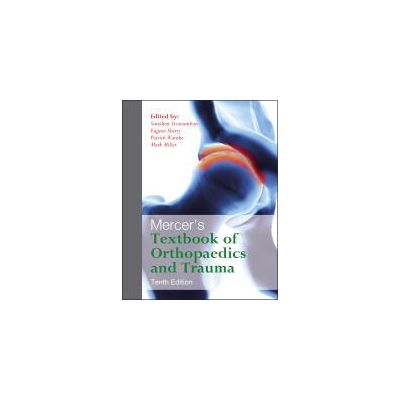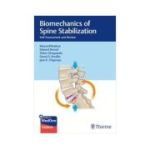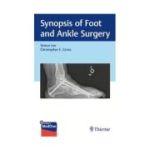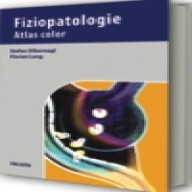Mercer's Textbook of Orthopaedics and Trauma

Preț: 945,00 lei
Disponibilitate: în stoc la furnizor
Autor: Sureshan Sivananthan, Eugene Sherry, Patrick Warnke, Mark Miller
ISBN: 9780340942031
Editura: Hodder Arnold
Anul publicarii: 2012
Ediția: 10
Pagini: 1598
Categoria: ORTHOPEDICS
DESCRIERE
Orthopaedic problems account for over one third of all medical and surgical problems. Mercer's Textbook of Orthopaedics and Trauma provides all the information required by the senior trainee or qualified specialist to improve understanding and management of any given condition or disease in this area.
Since its first edition over 75 years ago, Mercer's Textbook of Orthopaedics and
Trauma has been the definitive orthopaedic text, integrating clinical knowledge of
musculoskeletal disorders with the latest basic science research. Now in its tenth
edition, it has been comprehensively revised by a stellar team of international authors.
The Editors have sought to create the ultimate orthopaedic text, which is evidence
based and an excellent source of information reflecting the knowledge distilled from worldwide literature, clinical experience, basic science research and various orthopaedic exit examinations.
Key features
Rewritten by an international team of Editors and Authors, including world- renowned experts in the various areas of orthopaedic surgery and trauma
New Trauma section included
2-colour presentation to improve appearance and readability
Key facts and evidence base highlighted throughout
Mercer's Textbook of Orthopaedics and Trauma will be invaluable to trauma
and orthopaedic surgeons at all stages of their professional lives. It will also be an
indispensable reference for clinicians, rheumatologists, primary care physicians and
many other health professionals who need a reliable and authoritative guide of up-todate,
defi nitive information on the musculoskeletal system.
The ebook edition is in VitalBookTM Bookshelf - an ebook reader which allows you to:
download the ebook to your computer, access it anywhere with an internet browser or download free apps to read on your iPhone or iPad.
search the full text of all of the ebooks that you hold on your bookshelf for instant access to the information you need
link through from references to PubMed
make and share notes and highlights on your ebooks
copy and paste text and figures for use in your own documents and presentations
customize your view by changing font size and layout
Completely rewritten, reorganised content, bringing the Mercer's name into the 21st century
2-colour presentation to improve appearance in view of stiff US competition
Truly international cast of Editors and Authors, including world-reknowned experts in the various areas of orthpaedic surgery and trauma
Chapters written to a standard template to bring a cohesive feel to the book.
Key facts boxes in each chapter provide the reader with key information they will need to revise for their exams.
Bundled with Vital Source e-book
Table of Contents:
Section 1: Introduction.
1.1: History of Trauma and Orthopaedic Surgery
1.2: Clinical History and Examination Techniques.
1.3: Research Methods, Epidemiology and Statistics
Section 2: Anatomy and Physiology and Pharmacology:
2.1: Surgical Anatomy and Embryology of the Musculoskeletal System.
2.2: Bone Physiology and Repair
2.3: Soft Tissue Physiology and Healing
2.4: Central and Peripheral Nervous System.
2.5: Peri, Intra and Post Operative Care
2.6: The Physiology of Aging
2.7: Principles of Orthopaedic Pharmacology.
Section 3: Basic Science
3.1: Molecular and Cell Biology, Immunology and Genetics
3.2: Musculoskeletal Imaging
3.3: Nuclear Medicine
3.4: Biomechanics and Biomaterials.
3.5 Metabolic Bone Disease
3.6: Developmental and Inflammatory Conditions
3.7: Kinesiology
3.8: Infection
Section 4: Trauma
4.1: ATLS and Polytrauma
4.2: Major Incident Management
4.3: The Closed Treatment of Common Fractures
4.4: Principles of Operative Fracture Fixation, (AO).
4.5: Shoulder Girdle and Humerus Fractures.
4.6: Elbow and Forearm
4.7: Wrist and Hand Fractures.
4.8: Pelvic and Acetabular Fractures
4.9: Hip and Proximal Femur
4.10: Femoral Fractures
4.11 Knee and Tibia
4.12: Ankle Fractures
4.13: Foot Fractures
4.14: Spinal Fractures
4.15: Paediatric Fractures and Dislocations.
4.16: Management of Infections and Non-Unions. (Complications).
Section 5: Paediatric Orthopaedic Surgery
5.1: Clinical Assessment, Investigations and Screening
5.2: Bone Dysplasias
5.3: Chromosomal Disorders
5.4: Metabolic Diseases
5.5: Infections
5.6: Neuromuscular Affections.
5.7: Paediatric Spine
5.8: Upper Extremity
5.9: Lower Extremity
5.10: Adolescent Disorders
5.11: Syndromes
Section 6: Sports Medicine
6.1: Exercise Physiology, Epidemiology and Special Considerations
6.2: Pathophysiology of Cartilage, Meniscus, Tendon and Ligament.
6.3: Essential Arthroscopic Skills and Concepts.
6.4: Shoulder
6.5: Elbow, Wrist and Hand
6.6: Pelvis, Hip and Thigh
6.7: The Knee
6.8: Leg, Foot and Ankle.
Section 7: Musculoskeletal Oncology
7.1: Pathophysiology, Molecular and Cell Biology of Tumours.
7.2: Clinical Evaluation, Principles of Biopsy and Staging.
7.3: Principles of Chemotherapy and Radiotherapy.
7.4: Bone Tumours
7.5: Soft Tissue Tumours
7.6: Metastatic Tumours
7.7: Tumour Reconstruction Surgery
7.8: Amputations
7.9: Prosthetics and Orthotics
Section 8: The Spine
8.1: History, Physical Examination and Investigations
8.2: Pathophysiology of Back Pain
8.3: Spinal Biomechanics
8.4: Cervical Spine
8.5: Thoracic Spine
8.6: Lumbosacral Spine
8.7: Scoliosis
8.8: Spinal Instrumentation
8.9: Complications and Management Thereof
8.10: Non-Fusion Technologies.
Section 9: Adult Reconstruction Surgery
9.1: Arthritis
9.2: AVN / Osteonecrosis
9.3: Principles of Arthroplasty / Methods of Fixation
9.4: Alternatives to Arthroplasty (Osteotomies)
9.5: Upper Limb
9.6: Primary THA
9.7: Revision THA
9.8: Primary TKA
9.9: UKA
9.10: Revision TKA
9.11: Bone Conserving Options
9.12: Ankle Arthroplasty
9.13: Wear
9.14: Strategies in Managing Infections
9.15: Periprosthetic Fractures
9.16: Other Complications
Section 10: Hand and Upper Limb:
10.1: Finger tip Injuries
10.2: Tendon Injuries
10.3: Nerve and Vessel Injuries
10.4: Dupuytrens
10.5: Tendonitis and Triggering
10.6: Osteoarthritis
10.7: Rheumatoid Arthritis
10.8: Arthrodesis
10.9: The Thumb
10.10: Replantation and Microsurgery
10.11: Nerve Compression Syndromes
Section 11: Foot and Ankle
11.1: Ligament and Tendon Injuries
11.2: Hallux Valgus
11.3: Lesser Toe Deformities
11.4: Pes Planus and Pes Cavus
11.5: The Diabetic Foot
11.6: Neurologic Disorders
11.7: The Rheumatoid Foot
11.8: Nerve Compression Syndromes
Section 12: Current Controversies
12.1: Minimal Invasive Surgery (MIS)
12.2: Computer Aided Orthopaedic Surgery (CAOS)
12.3: MIS Meets CAOS.
12.4: Tissue Engineering
12.5: Genomics and Proteomics
12.6: Endocultivation
12.7: Bone Antibacterial Peptides
12.8: Selected Ethical Issues
12.9: Occupation Related Illness and Compensation.
Since its first edition over 75 years ago, Mercer's Textbook of Orthopaedics and
Trauma has been the definitive orthopaedic text, integrating clinical knowledge of
musculoskeletal disorders with the latest basic science research. Now in its tenth
edition, it has been comprehensively revised by a stellar team of international authors.
The Editors have sought to create the ultimate orthopaedic text, which is evidence
based and an excellent source of information reflecting the knowledge distilled from worldwide literature, clinical experience, basic science research and various orthopaedic exit examinations.
Key features
Rewritten by an international team of Editors and Authors, including world- renowned experts in the various areas of orthopaedic surgery and trauma
New Trauma section included
2-colour presentation to improve appearance and readability
Key facts and evidence base highlighted throughout
Mercer's Textbook of Orthopaedics and Trauma will be invaluable to trauma
and orthopaedic surgeons at all stages of their professional lives. It will also be an
indispensable reference for clinicians, rheumatologists, primary care physicians and
many other health professionals who need a reliable and authoritative guide of up-todate,
defi nitive information on the musculoskeletal system.
The ebook edition is in VitalBookTM Bookshelf - an ebook reader which allows you to:
download the ebook to your computer, access it anywhere with an internet browser or download free apps to read on your iPhone or iPad.
search the full text of all of the ebooks that you hold on your bookshelf for instant access to the information you need
link through from references to PubMed
make and share notes and highlights on your ebooks
copy and paste text and figures for use in your own documents and presentations
customize your view by changing font size and layout
Completely rewritten, reorganised content, bringing the Mercer's name into the 21st century
2-colour presentation to improve appearance in view of stiff US competition
Truly international cast of Editors and Authors, including world-reknowned experts in the various areas of orthpaedic surgery and trauma
Chapters written to a standard template to bring a cohesive feel to the book.
Key facts boxes in each chapter provide the reader with key information they will need to revise for their exams.
Bundled with Vital Source e-book
Table of Contents:
Section 1: Introduction.
1.1: History of Trauma and Orthopaedic Surgery
1.2: Clinical History and Examination Techniques.
1.3: Research Methods, Epidemiology and Statistics
Section 2: Anatomy and Physiology and Pharmacology:
2.1: Surgical Anatomy and Embryology of the Musculoskeletal System.
2.2: Bone Physiology and Repair
2.3: Soft Tissue Physiology and Healing
2.4: Central and Peripheral Nervous System.
2.5: Peri, Intra and Post Operative Care
2.6: The Physiology of Aging
2.7: Principles of Orthopaedic Pharmacology.
Section 3: Basic Science
3.1: Molecular and Cell Biology, Immunology and Genetics
3.2: Musculoskeletal Imaging
3.3: Nuclear Medicine
3.4: Biomechanics and Biomaterials.
3.5 Metabolic Bone Disease
3.6: Developmental and Inflammatory Conditions
3.7: Kinesiology
3.8: Infection
Section 4: Trauma
4.1: ATLS and Polytrauma
4.2: Major Incident Management
4.3: The Closed Treatment of Common Fractures
4.4: Principles of Operative Fracture Fixation, (AO).
4.5: Shoulder Girdle and Humerus Fractures.
4.6: Elbow and Forearm
4.7: Wrist and Hand Fractures.
4.8: Pelvic and Acetabular Fractures
4.9: Hip and Proximal Femur
4.10: Femoral Fractures
4.11 Knee and Tibia
4.12: Ankle Fractures
4.13: Foot Fractures
4.14: Spinal Fractures
4.15: Paediatric Fractures and Dislocations.
4.16: Management of Infections and Non-Unions. (Complications).
Section 5: Paediatric Orthopaedic Surgery
5.1: Clinical Assessment, Investigations and Screening
5.2: Bone Dysplasias
5.3: Chromosomal Disorders
5.4: Metabolic Diseases
5.5: Infections
5.6: Neuromuscular Affections.
5.7: Paediatric Spine
5.8: Upper Extremity
5.9: Lower Extremity
5.10: Adolescent Disorders
5.11: Syndromes
Section 6: Sports Medicine
6.1: Exercise Physiology, Epidemiology and Special Considerations
6.2: Pathophysiology of Cartilage, Meniscus, Tendon and Ligament.
6.3: Essential Arthroscopic Skills and Concepts.
6.4: Shoulder
6.5: Elbow, Wrist and Hand
6.6: Pelvis, Hip and Thigh
6.7: The Knee
6.8: Leg, Foot and Ankle.
Section 7: Musculoskeletal Oncology
7.1: Pathophysiology, Molecular and Cell Biology of Tumours.
7.2: Clinical Evaluation, Principles of Biopsy and Staging.
7.3: Principles of Chemotherapy and Radiotherapy.
7.4: Bone Tumours
7.5: Soft Tissue Tumours
7.6: Metastatic Tumours
7.7: Tumour Reconstruction Surgery
7.8: Amputations
7.9: Prosthetics and Orthotics
Section 8: The Spine
8.1: History, Physical Examination and Investigations
8.2: Pathophysiology of Back Pain
8.3: Spinal Biomechanics
8.4: Cervical Spine
8.5: Thoracic Spine
8.6: Lumbosacral Spine
8.7: Scoliosis
8.8: Spinal Instrumentation
8.9: Complications and Management Thereof
8.10: Non-Fusion Technologies.
Section 9: Adult Reconstruction Surgery
9.1: Arthritis
9.2: AVN / Osteonecrosis
9.3: Principles of Arthroplasty / Methods of Fixation
9.4: Alternatives to Arthroplasty (Osteotomies)
9.5: Upper Limb
9.6: Primary THA
9.7: Revision THA
9.8: Primary TKA
9.9: UKA
9.10: Revision TKA
9.11: Bone Conserving Options
9.12: Ankle Arthroplasty
9.13: Wear
9.14: Strategies in Managing Infections
9.15: Periprosthetic Fractures
9.16: Other Complications
Section 10: Hand and Upper Limb:
10.1: Finger tip Injuries
10.2: Tendon Injuries
10.3: Nerve and Vessel Injuries
10.4: Dupuytrens
10.5: Tendonitis and Triggering
10.6: Osteoarthritis
10.7: Rheumatoid Arthritis
10.8: Arthrodesis
10.9: The Thumb
10.10: Replantation and Microsurgery
10.11: Nerve Compression Syndromes
Section 11: Foot and Ankle
11.1: Ligament and Tendon Injuries
11.2: Hallux Valgus
11.3: Lesser Toe Deformities
11.4: Pes Planus and Pes Cavus
11.5: The Diabetic Foot
11.6: Neurologic Disorders
11.7: The Rheumatoid Foot
11.8: Nerve Compression Syndromes
Section 12: Current Controversies
12.1: Minimal Invasive Surgery (MIS)
12.2: Computer Aided Orthopaedic Surgery (CAOS)
12.3: MIS Meets CAOS.
12.4: Tissue Engineering
12.5: Genomics and Proteomics
12.6: Endocultivation
12.7: Bone Antibacterial Peptides
12.8: Selected Ethical Issues
12.9: Occupation Related Illness and Compensation.
Categorii de carte
-Comandă specială
-Edituri
-Promo
-Publicaţii Callisto
-Cărţi noi
-- 2551,50 leiPRP: 2835,00 lei
- 3024,00 leiPRP: 3360,00 lei
- 2956,80 leiPRP: 3360,00 lei
Promoţii
-- 170,10 leiPRP: 378,00 lei
- 2551,50 leiPRP: 2835,00 lei
- 3024,00 leiPRP: 3360,00 lei













REVIEW-URI